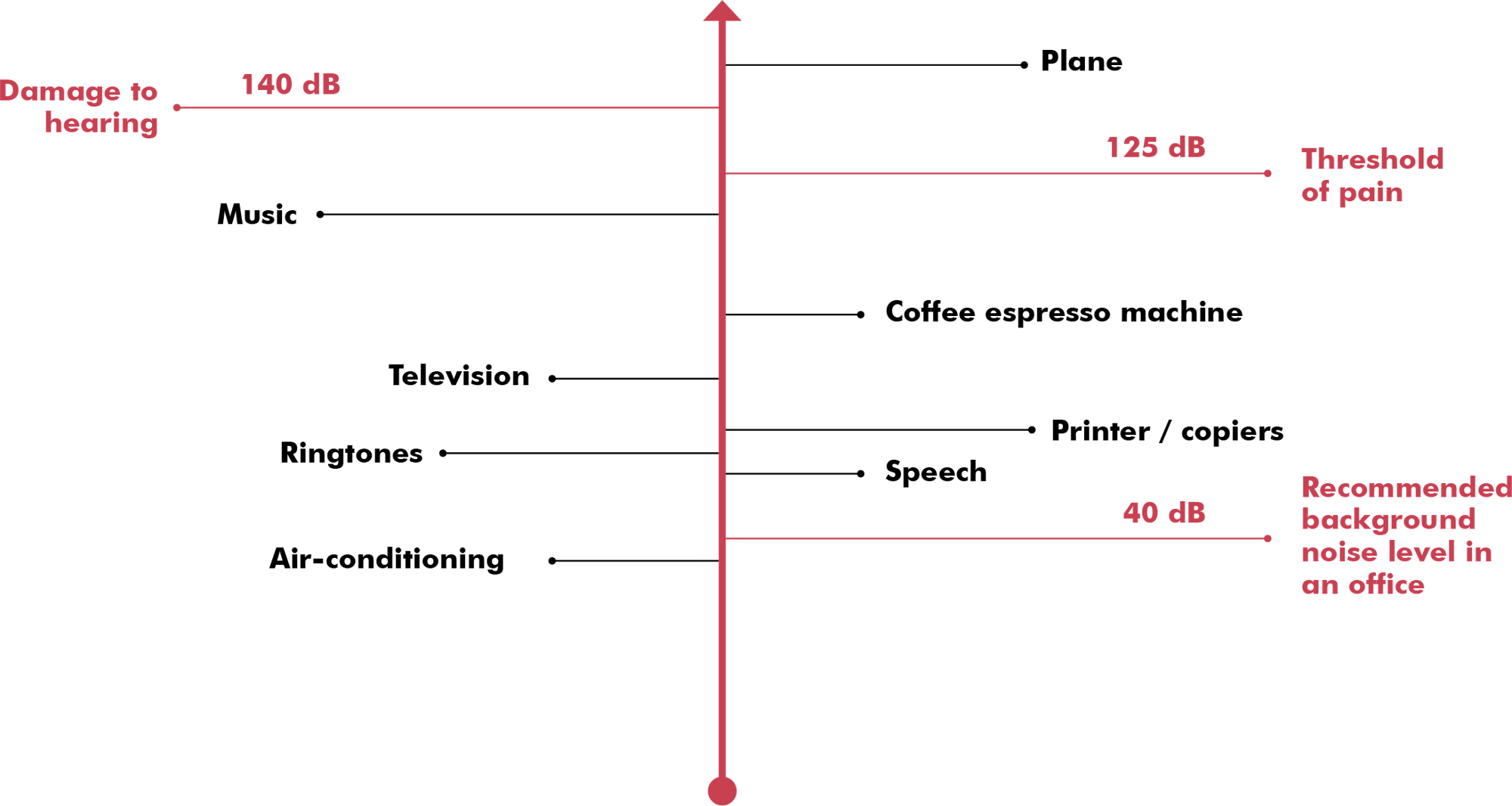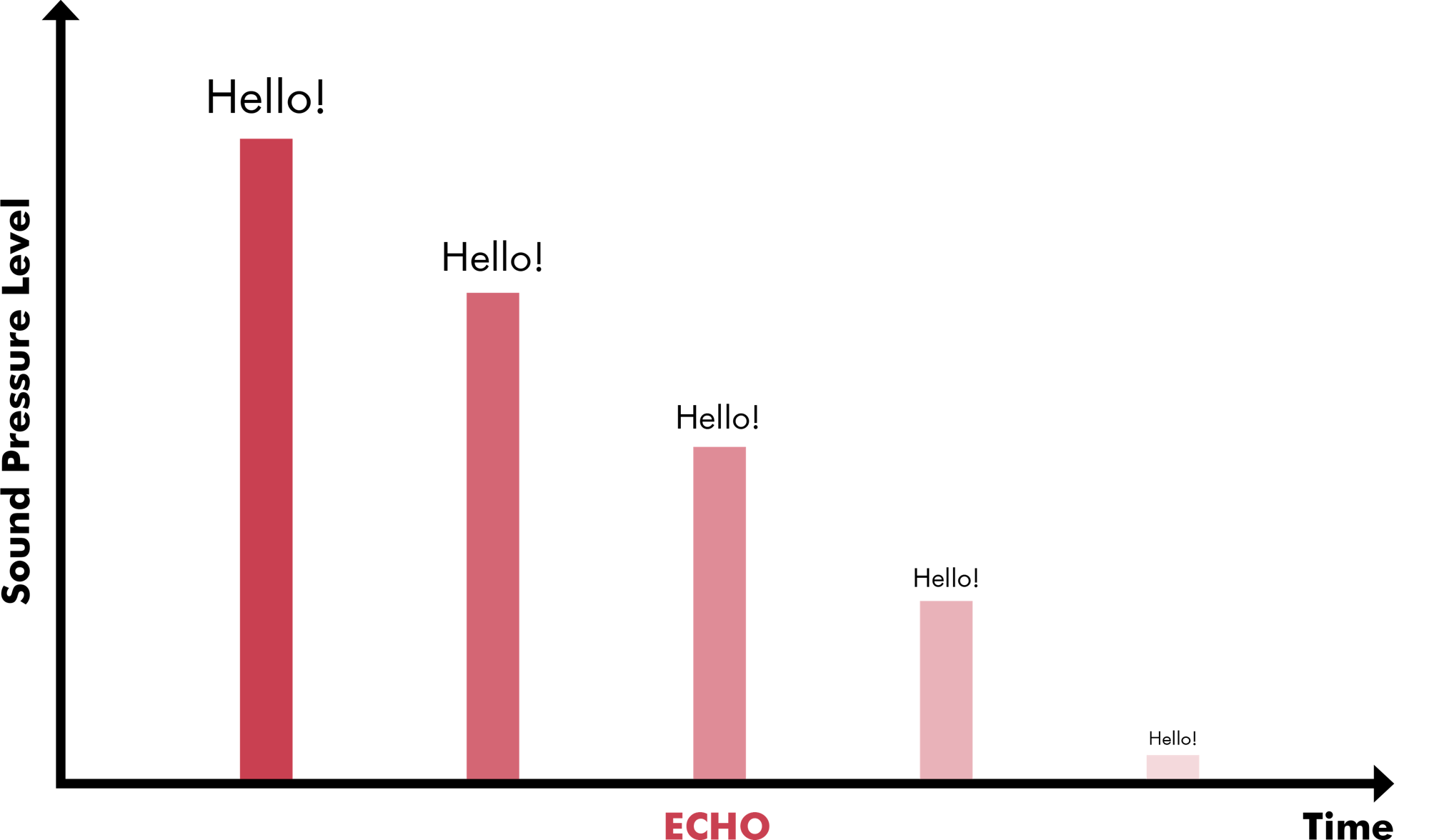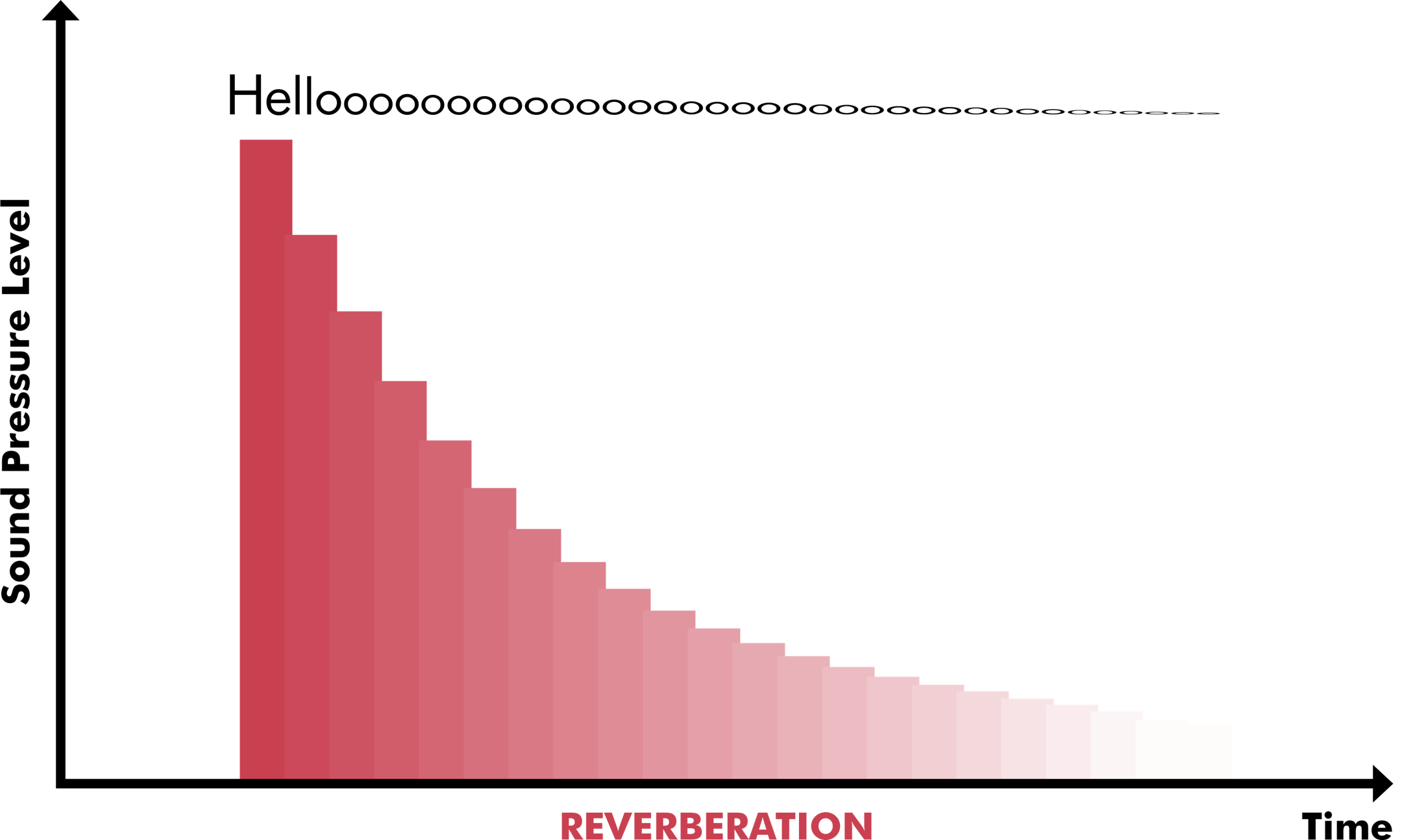
A well-balanced room with a perfect acoustic level is a key factor to the performance and well-being of workers all over the world.
If you would like to treat sound within a room, you should start by understanding the basic terminology of acoustics. And, like a lot of things, better acoustic performance begins with solid fundamentals.
What you’ll learn in this guide:
- Definition of sound: Frequency, Decibels & Reverberation time
- Building acoustics vs. Room acoustics
- Principles for good acoustics: Absorption, Attenuation & Diffusion
1. Definition of sound
Sound consists of pressure waves running through the air. It can be described as energy, created by vibrations, transmitted through air or any other medium. The inner ear converts those vibrations into electric signals, which are sent to our brain, where they will be processed and perceived as the actual sound coming in.
These sound waves have two different characteristics:
- Frequency determines the tone of the sound
- Decibel determines the intensity of sound
— Frequency: how sound waves travel
The wavelength determines the sound frequency. It is measured as the number of repetitive vibrations per cycle per second and is expressed in Hertz.
The audible range of sound is between 20 to 20 000 Hz. The higher the frequency, the higher the tone. However, for space planning, the suggested frequency ranges from 100 Hz to 5000.
High tones
High frequency | Short wave | 2500 - 12000 Hz | e.g. ringtones, consonants

Mid tones
Speech frequency | Mid length wave | 250 - 2500 Hz | e.g. speech

Low tones
Low frequency | Long wave | 50 - 250 Hz | e.g. HVAC, vowels

— Decibel: the intensity of sound
Decibel is a logarithmic unit to express the ratio of sound intensity (volume) and is important as an indicator of the background noise level. Humans can hear sounds between 0 and 140 decibels. The value of decibels has no direct or indirect correlation with the sound frequency.
For example, the ticking of a clock and the buzzing of a vacuum cleaner may have the same frequency but a different volume.
Why it matters? In today’s open-plan workspaces, employees are exposed to noise pollution. The level of noise ranges from 60 to 80 decibels, whereas recommended background noise level in an office is around 45 dB.
Noisy offices above the suggested threshold may hamper:
- concentration & productivity
- Speech privacy
- Overall acoustic comfort & wellbeing
But there is always a way to avoid getting stressed by trying to keep focus at work. The solution could be several workplace microenvironments, designed with sound balance in mind for the activity and the people using these areas.

— Reverberation time: the time for a sound to drop dead
Reverberation time is the time needed for an original sound source to decay by 60 dB and is expressed in seconds. In order to generate excellent speech intelligibility and clarity, the reverberation time should be adjusted and balanced by means of absorptive material in function of the specific acoustical issues in a given space. The reverberation time will always be influenced by
- the volume of the room,
- room temperature, and
- existing absorptive materials in the room, e.g. materials, objects, and people.
Recommended reverberation time for different spaces (measured in seconds):
- Office: 0.7 – 0.9s
- Meeting room: 0.4 – 0.8s
- Cafeteria: 1.00s
- Gymnasium: 1.50s
- Auditorium: 1.50 to 2.00s
Try measuring the reverb time in your space with the BuzziSpace RT60 app. It allows you to simulate the improvement in room acoustics by adding sound-absorbing products. Download the app in the App Store, available for both iPhone and iPad.
Why it matters? In an office, high reverberation levels intensify noise levels and reduce speech clarity, as the sound reflects from walls and tables, among other hard surfaces.
The way to dampen reverberation is with absorption materials.


2. Building acoustics vs. Room acoustics
— Building acoustics
Building acoustics and room acoustics may sound like two sides of the same coin, but don’t be fooled. We have to make a clear distinction, as the solutions to treating problems associated with either of the two are very different. As the name implies, building acoustics has to do with the building and the transmission of sound from outdoor to indoor and between structural elements of a building, e.g. floors and walls.
This is the case when:
- Sound is transferred from outdoor to indoor, e.g. cars, trams, airplanes passing by
- Sound is transferred between floors, e.g. footsteps from the floors above
- Sound is transferred between adjacent rooms, e.g. an adjacent meeting room
Ideally, issues like these should be addressed by the architectural team through the insulation of windows, walls, ceilings, and floors. Another option is to remedy the transmission of sounds, so they will not escape the room, to begin with.

— Room acoustics
Room acoustics, pertain to noise and sounds within a room or any given space. Rather than focusing on insulation to remedying transmission of sounds, the key to room acoustics is absorption to prevent sound waves from bouncing back-and-forth in a room.

3. Principles for good acoustics
To create a better acoustical environment and reduce reverberation time in a room, BuzziSpace acoustic solutions are developed to perform on one or more of the following acoustic principles.
— Absorption
Sound Waves are absorbed by any acoustically soft material they encounter.
Sound is energy, and in order to stop this energy from propagating, absorptive panels must be used to convert this energy into heat through friction. The absorption coefficient of a product will determine the level and quality of absorption. Absorption solutions can be applied to fixed wall or ceiling elements, e.g. BuzziBlox, BuzziLand, BuzziPod.
— Attenuation
Reducing the sound transfer within a room.
In order to reduce the sound transfer between different spaces, vertical elements will be applied to cut down sound energy, either pending from the suspended from the, ceiling, free-standing or desk-based. Those can come in different shapes such as vertical ceiling panels, room dividers, desk screens along with a range of acoustic essentials. Never underestimate how attenuation or sound dampening has a positive impact on speech intelligibility and clarity. It’s no wonder that a positive acoustic experience that absorbs disturbing sounds leads to a quieter space, fosters focus and inspires effective collaboration within an energetic workspace.
— Diffusion
Sound energy is spread evenly in a given space.
Wavelengths, which can’t be absorbed through acoustic treatment, will dissipate evenly back into the room, ensuring a better spread while maintaining a live, vivid sound. Otherwise, the sound will be reflected back in a linear way, resulting in a remaining unpleasant sound. This property can be obtained by alternating different depths of absorptive material and 3D shapes such as BuzziTile 3D and BuzziBrickBack. Check out other solutions.
Need acoustic advice?
Related articles
Idea Starters
3 Acoustic Solutions for an Added Layer of Privacy
Designing open spaces that feel both connected and functional is a delicate balancing act. That’s where acoustic solutions step in, not just to absorb sound, but to define zones, guide flow, and elevate well-being.
Stories
The Quiet Revolution: Eco-Conscious Acoustic Solutions for Sustainable Spaces
The introduction of our next-generation solutions sets a new standard for eco-friendly living and workspaces.
Projects
A Taste of Acoustic Comfort: Ristorante Da Franco Gets a Sound Makeover
Step inside Ristorante Da Franco in Seriate, where great food meets great acoustics, thanks to the sleek installation of BuzziJet.
Projects
Sanctuary by Design: How Thoughtful Acoustics Create Comfort for Young Refugees
The collaboration between BuzziSpace, MBSY and KJHV proves that design can be an act of radical empathy.
Stories
BuzziBrella Wins Interior Design Best of Year Award!
The acoustic shelter has won the 2024 Interior Design Best of Year Award in the Contract Furniture System category.
Projects
Digital Serenity: Dell Embraces Acoustic Excellence in Slovakia
Elevating the tech giant's workspace to new heights of harmony and focus.
Idea Starters
New Products: BuzziBrella, BuzziNest Office & BuzziNest Room
Unveiled at Orgatec 2024!
Stories
An Island of Calm: Finding Shelter With BuzziBrella
Creating an acoustic oasis for large spaces is no easy task. Renowned designer Sebastian Herkner delves into the inspiration and design process behind the innovative BuzziBrella, blending aesthetics with acoustic functionality to create a unique space solution.
Stories
Mushroom Power: The Magic Behind BuzziSpace’s Mycelium Acoustic Panels
Designed with a commitment to sustainability, BuzziSpace's mycelium-based acoustic panels harness the intricate root structure of fungi, which is 100% grown and crafted from local organic waste materials in Europe, serving as a fully biodegradable alternative to other acoustic panels in the company's award-winning catalog.
Stories
BuzziHug Work Wins 2024 HiP Award
Our coziest workstation has been selected as the 2024 HiP Awards Winner in the Workplace: Furniture category!
Stories
Nature’s Inspiration: Inside the World of BuzziShroom
With an eye for detail and a passion for pushing boundaries, Cory Grosser unveils the inspiration, challenges, and triumphs that flourished in the creation of BuzziShroom.
Stories
Creating Cozy Environments, Stitch by Stitch: Maison Tricot x BuzziSpace
Read the full background story on our exclusive collaboration with knitwear and design experts, Maison Tricot.
Stories
BuzziPebl Light Nominated for Mix Interiors Awards 2024
Winners will be announced on June 27th!
Idea Starters
How to Design for Well-Being
We share our ABCs for optimizing acoustics in hybrid spaces.
Idea Starters
New Product: BuzziReDesk
Introducing BuzziReDesk – Redefining Your Workspace With Sustainable Style
Idea Starters
Your MeSpace in Less Than 15 mins
Our new pre-assembled BuzziNest Booth option makes it easier and quicker for you to enjoy some privacy.
Events
BuzziAcademy: Well-Being by Design: Optimizing Acoustics in Hybrid Spaces
Thanks for joining us. Stay tuned for the next installment.